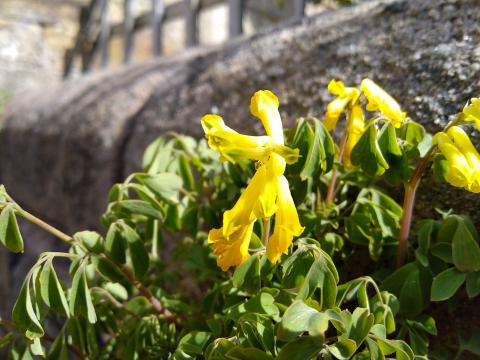Yellow Corydalis

One of the annual treats of attending Salem Chapel is beholding the little bushes of Yellow Corydalis sprouting out of its walls in late spring. The bright yellow flowers and lush foliage soften its stony appearance. It is native to the Italian and Swiss Alps but has been grown here since the 1590s. It seems to love old walls with their obvious drainage and decaying mortar. I always marvel that the plants seem to return, even after a bad winter. They can survive down to -36 degrees centigrade, which is colder than my body could tolerate. Although they may never have faced such chilly temperatures in this land, their mountainous origins prepared them well for such winters as we have. Curiously, the botanist Heinz Ellenberg determined that corydalis has a very low salt tolerance. This seems strange for a plant which loves to grow in walls and masonry, which are natural containers of salt. Yet in time, efflorescence (the stone’s natural salts) come out. This is why the Corydalis grows best in old walls and pavements, where the natural salt content has been reduced by years of precipitation. A new stone wall just would not allow these bright little plants to flourish. So although our aged building is a financial liability, its age encourages this annual floral tribute.
Many consider we Martin Toppers an old-fashioned bunch. For example, we still use hymnbooks. We still sing hymns. We still sing. To people expecting lightshows and worship bands, we must seem a dreary lot. Yet in our old walls and plain, old services, one will hear the beauty of God’s saving grace. There are many more modern fellowships where such wonderful truth will not be heard
- Log in to post comments


 Sunday Worship 10.45am & 6.00pm
Sunday Worship 10.45am & 6.00pm